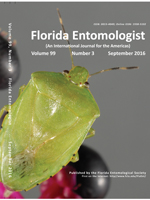The Asian citrus psyllid vectors bacteria responsible for a serious citrus disease known as huanglongbing (also known as citrus greening). Many research endeavors on huanglongbing are dependent on a steady supply of Asian citrus psyllid, which can be facilitated using laboratory or greenhouse colonies maintained on an Asian citrus psyllid host plant. The choice of a plant species may be influenced by the flushing characteristics of a genotype, particularly if the goal is to produce large numbers of psyllids. This is because Asian citrus psyllid is dependent on flush (new young leaves) for reproduction. To expedite rearing, plants can be trimmed to stimulate flush growth. We studied the flushing characteristics of 9 plant genotypes known to be highly susceptible to colonization by Asian citrus psyllid: Afraegle paniculata (Schumacher) Engl., Bergera koenigii L., Citrus aurantiifolia (Christm.) Swingle, C. macrophylla Wester, C. maxima (Burm.) Merr., C. medica L., C. reticulata Blanco, C. taiwanica Tanaka & Shimada, and Murraya paniculata (L.) Jack. (all: Rutaceae). When plants were trimmed at 7 mo after planting, the following produced the greatest number of flush shoots: B. koenigii, C. aurantiifolia, C. macrophylla, and M. paniculata. Pruning plants once or twice before a final trimming at 7 mo after planting did not increase the number of flush shoots produced per plant for any of the genotypes. The number of psyllids produced per flush shoot was assessed on 5 genotypes that produced good quantities of flush: B. koenigii, C. aurantiifolia, C. macrophylla, C. taiwanica, and M. paniculata. Although some significant differences among the genotypes were observed with respect to when new adults first began to emerge and when peak emergence occurred, the differences were relatively small (a day or two). During a winter experiment, numbers of psyllids produced per flush shoot were relatively small, but significantly greater numbers of new adults were produced on C. aurantiifolia than on C. taiwanica or M. paniculata. Greater numbers of adults per shoot were produced during warmer weather, with no significant differences among plant genotypes. Regardless of plant genotype or time of year and for reasons that were not clear, small percentages of adults developed wing deformities. There were no differences in sex ratio, and few differences in abdominal color, among Asian citrus psyllid reared on the tested plant genotypes.
How to translate text using browser tools
1 September 2016
An Evaluation of Plant Genotypes for Rearing Asian Citrus Psyllid (Hemiptera: Liviidae)
David G. Hall,
Matthew G. Hentz

Florida Entomologist
Vol. 99 • No. 3
September 2016
Vol. 99 • No. 3
September 2016
Bergera
citrus greening
cría de insectos
enverdecimiento de los cítricos
Huanglongbing
insect rearing
Murraya




